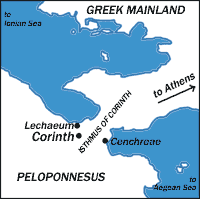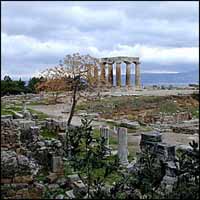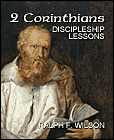
|
Old Testament
New Testament
Gospels
Acts
Paul's Letters
General Letters
Revelation
Topical Studies
Beginning the Journey (for new Christians). en Español

|
Old Testament
New Testament
Gospels
Acts
Paul's Letters
General Letters
Revelation
Topical Studies

|
Home
Bible Studies
Articles
Books
Podcasts
Search
Menu
Donate
About Us
Contact Us
FAQ
Sitemap
The City of Corinth
 The ancient city of Corinth showed signs of human habitation
as far back as the Early Neolithic period.
The ancient city of Corinth showed signs of human habitation
as far back as the Early Neolithic period.
Its location was ideal, with an abundant water supply, only 1.5 miles south of the Isthmus of Corinth, a narrow land bridge (only 3.9 miles or 6.3 kilometers wide), which connects the Peloponnesian peninsula to the Greek mainland. Thus Corinth became prosperous from trade "“ both the trade moving by sea from east and west, but also north and south between Greece and the Peloponnesus. The port of Cenchreae connected the city to the Aegean Sea to the east, while the port of Lechaeum was on the Ionian Sea. In 1893, a canal was cut across the isthmus to accommodate shipping, but in the days of the early church, there was no such luxury.
Ruins of the Temple of Apollo, dating to the sixth century BC, can still be seen. Shops and monuments lining the Agora, larger than the Forum in Rome, also persist. The Temple of Asclepius, the god of healing, was built on the north edge of the city. To the south, the Acro-Corinthian fortress at the height of 1,886 feet could control all the trade routes.
 Temple of Apollo and ruins in Corinth. Source: BiblePlaces.com |
At its peak stood the Temple of Aphrodite, goddess of love and beauty, where 1,000 female prostitutes served, contributing to the city's reputation for immorality. In fact, the coined Greek word "to Corinthianize" meant to practice immorality and the phrase "Corinthian girl" designated a prostitute.
The Romans conquered and destroyed Corinth in 146 BC. In 46 BC, Julius Caesar re-founded it as a Roman colony. In 27 AD, it became the seat of government for the Roman province of Achaia.[1] As a Roman colony, its citizens were primarily Romans, perhaps freedmen from Italy, but its population also included Greeks and a considerable Jewish community. As a chief trade center, it would become a strategic base of operations for Paul, since he would meet and minister to many people travelling through, causing the gospel to spread even farther.
Tentative Chronology of Paul and the Corinthians (50-56 AD)
Below, I've tried to outline in order what we can piece together of Paul's contacts with the Corinthian church.
- First Visit (50-52 AD). Paul first visited Corinth about 50 AD, during the last phase of his second missionary journey, after starting churches in Macedonia "“ Philippi, Thessalonica, and Berea (Acts 16-17). He came to Corinth after visĀiting Athens and stayed with a couple of Jewish tentmakers, Aquila and Priscilla, who had recently been forced to leave Rome due to an edict by Emperor Claudius (about 49 AD; Acts 18:2-3). Paul was joined in Corinth by Silas and Timothy. Under their ministry the church grew. Paul seems to have been in danger during this time, because the Lord spoke to him in a night vision:
"Do not be afraid, but speak and do not be silent; for I am with you, and no one will lay a hand on you to harm you, for there are many in this city who are my people" (Acts 18:9-10).
When the Jews appealed to the Roman proconsul Gallio (in office 51 to 52 AD) to force Paul to leave, they were rebuffed (Acts 18:12-17). Paul left Corinth probably in the spring of 52 AD, giving him two years in Corinth. After leaving Corinth, Paul stops at Ephesus and then returns to Antioch, and from there he goes to Jerusalem (Acts 20:18-22).
- "Previous Letter" from Paul is no longer extant. Paul, who is now in Ephesus (52 to 55 AD), writes to Corinth rebuking vice and fornication by church members (mentioned in 1 Corinthians 5:9-11). This letter is referred to by scholars as Corinthians A.
- Report to Paul: Chloe's people report to Paul about the party spirit and quarrels at Corinth.
- Letter to Paul: Stephanas, Fortunatas, and Achaicus probably bring Paul the letter that reports on problems at Corinth with marriage, divorce, food sacrificed to idols, spiritual gifts, and the collection he was organizing for the Jerusalem believers (1 Corinthians 16:17).
- Timothy is dispatched to Corinth to deal with some of the problems (1 Corinthians 4:17; 16:10-11).
- 1 Corinthians Letter: In the Spring of 55 AD, Paul writes during his final year at Ephesus the letter we know as 1 Corinthians concerning problems reported to him. Perhaps this letter was carried to Corinth by Stephanas. This is sometimes called Corinthians B. At this point Paul is planning a soon visit to MacĀedonia with a stop in Corinth. (1 Corinthians 4:18-21).
- Second visit, the "painful visit,"¯ is a quick trip to deal with troubles in Corinth that were serious enough to require direct personal confrontation (2:1; 13:2). During this visit Paul was personally attacked by one of the members (2:5; 7:12). This visit was difficult for both Paul and his converts in Corinth.
- "Tearful letter" or "severe letter"¯ from Paul (2:3-4), no longer extant, is written from Ephesus, probably carried by Titus in lieu of Paul going himself. In it, Paul apparently professed his love for the Corinthians and required them to discipline the man who had led in defying his apostolic authority on his second visit. This is sometimes referred to as Corinthians C. Apparently, this letter was quite effective in producing repentance (7:8-12).
- Proposed visits don't come to pass (1 Corinthians 16:1-8) due to intervening circumstances, such as severe danger in Asia and Paul's depression (1:8-10), as well as Paul's desire not to make another "painful visit" (2:1).
- Paul travels to Troas and Macedonia amidst various afflictions, but meets Titus there and is encouraged by his good report about the Corinthian church (7:5-7).
- "Super-Apostles" challenge Paul's authority, apparently Jewish Christians from Judea, perhaps seeking to impose the authority of the mother church over the Gentile churches. The "superlative apostles" (11:5; 12:11) seemed to bring another take on the gospel. Some believe that possibly Paul sent another letter (called Corinthians E, consisting of chapters 10-13) to counter these "super-apostles," but this is just speculation (see below under "Literary Problems"¯).[2]
- 2 Corinthians Letter: Paul sends our 2 Corinthians letter from Macedonia about 56 AD, sometimes called Corinthians D (at least chapters 1-9).
- Third Visit to Corinth occurs about 57 AD, when Paul gathers with those who are preparing to send the gift collected to relieve the Jerusalem saints (Acts 19:21-22). Apparently, matters have been resolved to some extent, since from Corinth Paul wrote to the Roman church:
"Macedonia and Achaia have been pleased to share their resources with the poor among the saints at Jerusalem" (Romans 15:26).
Paul stays in Corinth three months, then escapes to Macedonia to avoid a Jewish plot, meets his companions in Troas (Acts 20:1-5), and leaves for Jerusalem where he is arrested.[3]
We don't hear anything more about the Corinthian church after this until about 95 AD when Clement of Rome writes 1 Clement to address the disharmony at Corinth.
To summarize, Paul's letters to the Corinthian church seem to have been written during Paul's three-year ministry in Ephesus. First Corinthians was probably written from Ephesus about 55 AD. Second Corinthians was probably written from Macedonia in 56 AD, but the date is "complicated." Let me explain.
Literary Problems
The date isn't clear because of a problem understanding the seeming discontinuity between chapters 1-9 and chapters 10-13. Why does the mood change so abruptly to Paul's defense of his apostolic authority and denunciation of those who came to Corinth and tried to replace his authority among the converts? There have been several explanations:
- Prior letter. Chapters 10-13 preserve part of the "tearful letter" that Paul refers to in 2:3-4. In other words, some hold that chapters 10-13 (Corinthians C) was written prior to chapters 1-9 (Corinthians B). However, Bruce sees the reference to Titus visiting Corinth in 12:18 as the conclusive argument against dating chapters 10-13 before chapters 1-9.[4]
- Later letter. Chapters 10-13 belong to a later letter (Corinthians E).[5]
- Same letter. Chapters 10-13 are part of the same letter as 1-9, but were written after receiving some fresh news from Corinth. (This makes the most sense to me.)
Paul's Opponents in Corinth
Who are the visitors to Corinth who try to undermine Paul's authority there? Some have supposed them to be "Gnostics of ecstatic temperament and libertine ethics." Others see them as Judaizers. But most likely they are Palestinian Jews, not Judaizers in the Galatian sense, but perhaps men who tried to impose the authority of the mother church over the Christian world.[6] We'll discuss this further when we come to it in the text.
Situation
 Also available in e-book and paperback |
To summarize the situation, Paul is writing to a six-year-old church that he founded in 50-51 AD. Since he moved on, the church has encountered problems, particularly some Jewish Christian leaders who have worked to undermine Paul's influence so they could substitute their own. So in 2 Corinthians, Paul writes about 56 AD to restore his relationship with the church and regain his influence, so he can help them with the problems they are having with holiness and hardship, generosity and church order, and their testimony to the non-Christians around them.
End Notes
[1] Donald H. Madvig, "Corinth," ISBE 1:772-774.
[2] This section draws heavily on Bruce, 1 and 2 Corinthians, pp. 23-25, 164-166; and F.F. Bruce, Paul: Apostle of the Heart Set Free (Eerdmans, 1977), chapter 24, pp. 264-279.
[3] Bruce, Paul, pp. 339-340.
[4] Bruce, 1 and 2 Corinthians, pp. 168-169.
[5] Seeing chapters 10-13 as preserving a later correspondence (Corinthians E) is how Bruce tentatively resolves the issue (p. 169-170).
[6] Bruce, p. 174.
Copyright © 2025, Ralph F. Wilson. <pastor![]() joyfulheart.com> All rights reserved. A single copy of this article is free. Do not put this on a website. See legal, copyright, and reprint information.
joyfulheart.com> All rights reserved. A single copy of this article is free. Do not put this on a website. See legal, copyright, and reprint information.


 To be notified about future articles, stories, and Bible studies, why don't you subscribe to our free newsletter, The Joyful Heart, by placing your e-mail address in the box below. We respect your
To be notified about future articles, stories, and Bible studies, why don't you subscribe to our free newsletter, The Joyful Heart, by placing your e-mail address in the box below. We respect your